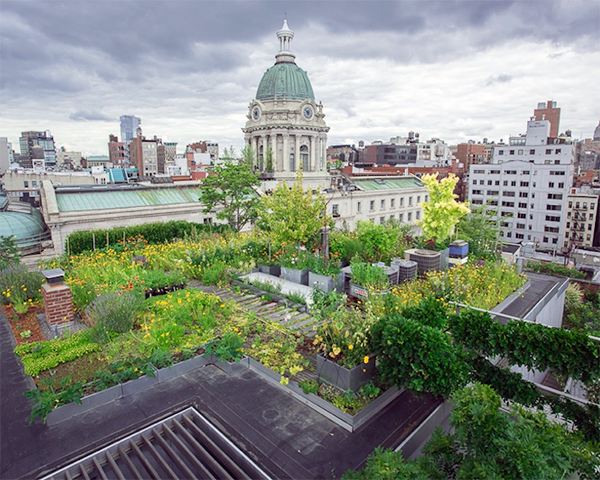
Remember when we took the LEED exam or when you started wondering how to keep the costs down in your house? You looked at “green roofs.” The photos usually had goats eating on the roof or you saw some Viking village. The photo in this article is a great example of an extensive green roof in the UK.
One of the many benefits being promoted with the green roofs idea is a happier workforce being closer to nature…” http://www.carbonsmart.co.uk/why-are-green-roofs-good-for-business/
Well, after my BRAG ride and a close encounter with fire ants, I am not sure how close to nature I want to be. But what are the alternatives for an eco-friendly roof? Enter the “blue roof” which focuses more on the collection of water than the growth of plants. This roof is supposed to be less costly to install and maintain (one of the problems of the green roof). “Compared to traditional roofs, blue roof technologies add only $1 to $4 per square foot” (Patrick, L., 2012).
In New York City, “rooftops comprise almost a third of NewYork City’s total impervious surface area” (NYC.Gov, 2013). City planners are looking at cost-effective ways to reduce runoff and to reduce costs. To determine the best solution they are studying the green and blue roofs side-by-side on a public school roof to see the differences in cost and effectiveness.
Green roofs are typically more expensive but I know that I am looking at a new roof for my house and the sound of goat hooves might be interesting but could be costly. Because a blue roof has no vegetation, there will be no fire ants or goats. Instead, capture of the rainwater runoff controls the flow of the water and stops the overflow into storm systems that tax the sewer systems and create water waste.
Michael Bloomberg said that using this type of technology could save NYC “$2.4 billion over 20 years” (Gralla, 2010). The blue roof might not be as pretty but being less costly could lead to a higher adoption rate and save some of that precious water that is now going into the sewage treatment system. The color of the roof can be reflective so that I can reduce my heating and cooling costs. I think that I will take a look at this possibility and stir up my Decatur neighbors.
Just some thoughts.
References:
(2013, NYC. Gov Blue Roof and Green Roof, http://www.nyc.gov/html/dep/html/stormwater/green_pilot_project_ps118.shtml & http://content.yudu.com/A1ouvx/CJSEP10/resources/46.htm)
(Patrick, L. 2012, June 7, Green Roof, White Roof, Blue Roof, New Roof! Save Money, Save the World, http://www.habitatmag.com/Publication-Content/2012/2012-May/Featured-Articles/Installing-Green-Roof-White-Roof-Blue-Roof#.Ub89eefVCo0)
(Gralla, Joan, Reuters, September, 28, 2010 http://www.reuters.com/article/2010/09/28/us-newyorkcity-water-idUSTRE68R67F20100928)


Great Article and informative links! My new roof is definitely taking on a whole new function when the time comes.
(Sorry ’bout those fire ants)